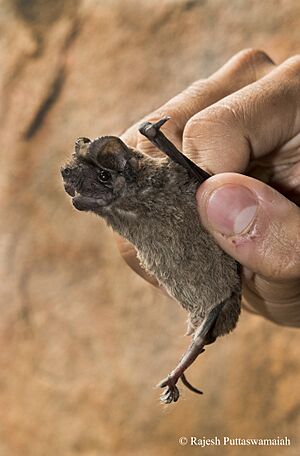Egyptian free-tailed bat facts for kids
Quick facts for kids Egyptian free-tailed bat |
|
|---|---|
 |
|
| Egyptian Free Tailed Bat | |
| Conservation status | |
| Scientific classification |
The Egyptian free-tailed bat is a fascinating creature! It's also known as the Egyptian guano bat. This bat belongs to a family called Molossidae. Its scientific name is Tadarida aegyptiaca. These bats are known for their unique tails.
Contents
What Does an Egyptian Free-Tailed Bat Look Like?
These bats have soft, thick fur. It's usually greyish-brown. The fur is darker on their head and back. It gets lighter on their belly, especially near the throat.
Their wings are thin and pointed. They have light brown membranes that you can see through. A short tail sticks out past the wing membrane. Their ears are rounded and sit close together on top of their head.
The bat's face looks a bit like a bulldog's. It has many wrinkles. This look gave the bat family its name, Molossidae. This name comes from ancient Epirote mastiff dogs called molossus. These bats are small. Their head and body are about 6–8 centimeters long. Their forearms are about 5 centimeters long.
Where Do Egyptian Free-Tailed Bats Live?
The Egyptian free-tailed bat lives in many places. You can find them across Africa. They are not in some parts of the northwest and east. They also live in Arabia and the Middle East. Their range goes as far east as Bangladesh and south to Sri Lanka. They are spread out but often found in specific local areas.
What Kind of Home Do They Like?
Egyptian free-tailed bats can live in many different places. They are found in dry savannas. They also live in humid upland areas. The most important thing for them is access to water. They need water to drink. Also, their insect food often gathers near water.
They also need safe places to rest during the day. They like to roost in cliff faces and caves. But they are also happy to use human-made spots. You might find them in old buildings or temples.
How Do Egyptian Free-Tailed Bats Behave?
Like most bats, the Egyptian free-tailed bat is active at night. During the day, they rest in groups called colonies. These colonies can be small, with just 3 bats. Or they can be huge, with thousands of bats!
They are very fast flyers. They can travel long distances at night. They hunt over open areas. They catch their food while flying. They can also pick up prey from the ground. Their diet includes beetles, caterpillars, flies, moths, spiders, termites, and wasps. They are not clumsy on the ground. They can move around quite well.
Their roosting spots have a strong smell. Scientists think this smell helps bats recognize their home. It might also help them interact with each other. Female bats usually have one baby each year. This often happens in the summer. Pregnancy lasts about four months.


